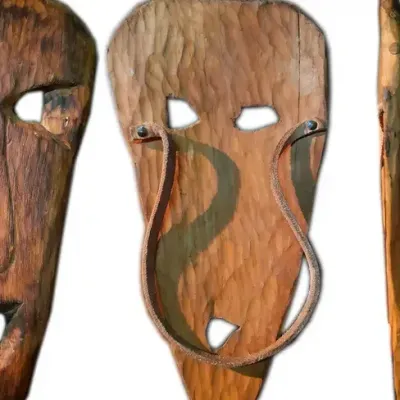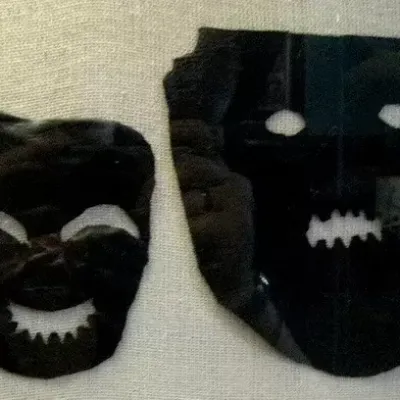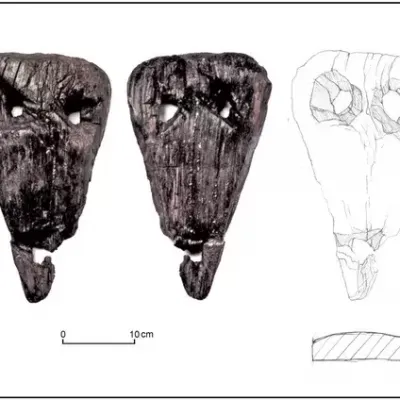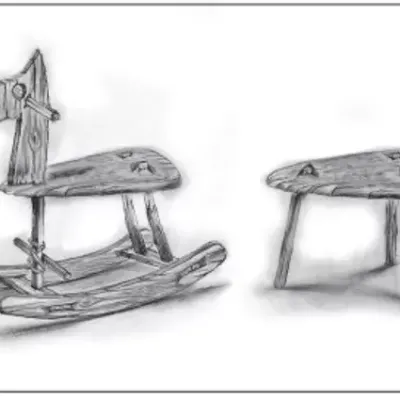Viktoria Greenboim Rich
Source - https://www.haaretz.com/archaeology/2023-02-01/ty-article/ancient-pagan-masks-debunked-by-archaeologists-in-poland/00000186-0bde-dd5c-a987-1fffbd7d0001
Iconic Slavic masks found half a century ago were thought to represent deeply rooted paganism perpetuated in Christian rituals. Reevaluation of these items brought quite a surprise
 Copy of the older so-called mask from OpoleCredit: Sławomir Uta/ Kamil Kajkowski, “Masks from Opole in the context of Medieval Slavic rites”, Archaeologia Polski 66, 2021, fig.11
Copy of the older so-called mask from OpoleCredit: Sławomir Uta/ Kamil Kajkowski, “Masks from Opole in the context of Medieval Slavic rites”, Archaeologia Polski 66, 2021, fig.11
It was while excavating a medieval stronghold in Poland in the 1960s that archaeologists discovered two unique wooden artifacts. Based on their resemblance to certain Slavic sculptures, they suggested these pieces were ritual masks used by ancient Slavs persevering in their pagan ways during Christmas processions.
A magical interpretation like that is hard to resist. In no time the artifacts became an icon of pre-Christian Slavic beliefs and ritual, among scientists and in the popular culture, and replicas began to appear in “modern pagan” and reenactment events.
Sixty years later, in 2021, Kamil Kajkowski, an archaeologist and head of the art and history department in the West Kashubian Museum in Bytów, Poland, decided it was about time to reevaluate the interpretation.
Kajkowski dedicates his research to the spiritual culture of medieval Western and Baltic Slavs. In 2021 he published an article in Archeologia Polski examining the artifacts, and concluded: these wooden items were not exactly as magical as previously thought.
It was in the course of excavating a medieval stronghold in the Polish city of Opole between 1959 to 1962 that archaeologists discovered the two ancient wooden items among the ruins.
The first was discovered in garbage layer between two 11th century buildings. Technically the artifact was a pine wood board about 34 centimeters (almost 13.5 inches) in length, 20 cm at its widest and with uneven thickness between 3.7 to 5.3 cm. It had two parallel holes across the broadest part and one in the lower, narrower part. The late archaeologist Helena Cehak-Hołubowiczowa, who led the expedition, identified the holes as representing eyes and a mouth, respectively.
The board was smoothed and slightly concave on the “outside” and flat and unfinished on the “inside” (hence the uneven thickness), and bears traces of red dye.
Cehak-Hołubowiczowa also identified a “line” running more or less down the central axis of the object, which she identified as an artistic representation of a nose.
The second purported mask was found in a 12th century building. This one was made of birch, not preserved as well, and was smaller: 23 cm in length and 18 cm at its widest. It too had varying thickness. In contrast to the first one, the “inner” side was smoothed out, while the “outer” was roughly processed.
It too seems to initially have had three holes, which Cehak-Hołubowiczowa interpreted the same way.
 Opole-Ostrówek, wooden "mask" from the mid-12th centuryCredit: Karol Szott/Kamil Kajkowski, "Masks from Opole in the context of Medieval Slavic rites", Archaeologia Polski 66, 2021, fig.3
Opole-Ostrówek, wooden "mask" from the mid-12th centuryCredit: Karol Szott/Kamil Kajkowski, "Masks from Opole in the context of Medieval Slavic rites", Archaeologia Polski 66, 2021, fig.3
Based on the anthropomorphic features that Cehak-Hołubowiczowa saw in the wooden objects; the fact that one was discovered not far from two wooden figurines of what looks like billy goats; and ethnographic descriptions of customs and Christmas carols persisting into the late the 19th or even early 20th century in these parts, she suggested these were ritual masks used during Christmas celebrations.
Kajkowski does not agree.
When we have no clue
Archaeologists joke that when they find something they don’t understand, they call it cultic. In actuality, defining something as cultic can be problematic. We don’t know what people thought back in the day, especially absent historic and visual evidence.
Thus over the years of archaeological research, scholars have looked for tools to define what might be cultic and what is not.
In general, to be considered “cultic,” an artifact cannot be explained solely in terms of functionality. It is helpful to find it in an area clearly serving as a temple or other sacred site. These often had hallmark architecture and tended to be located in liminal territories like caves, mountains, and beaches. Another telltale of a cultic item is that it isn’t found in mundane contexts.
In short, defining a mysterious item as cultic usually involves multiple lines of evidence.
Among cultic or potentially-cultic objects, masks in particular go back to at least the early Holocene. For example, stone masks have been found in the Near East, including in Israel, from about 9,000 years ago.
 Neolithic stone masks found in Israel from 9,000 years agoCredit: Emil Salman
Neolithic stone masks found in Israel from 9,000 years agoCredit: Emil Salman
Moving on thousands of years to classic Greece and Rome, some modern-day scholars suggest rituals honoring the ancestors provided the foundation for the emergence of the theatrical arts. Latin words for masks such as masca, larva and persona are linguistically connected to terms describing death, witchcraft, and hallucinations in Latin and Indo-European languages.
There is evidence that some people believed, and some do to this day, that ceremonial masks help them communicate with spirits, of animals, nature, the dead; transform and mediate between different realities and conditions; but we cannot be confident that masks in prehistory served similar purposes.
During the ages masks were also used to cover the faces of the deceased. All the above, coupled with the tendency towards face pareidolia, seeing a human face on a car, or Jesus (or Elvis) in toast, for instance, can lead to the identification of a mask where there may have been none.
Summoning the dead
Historically speaking, when it comes to the ancient Slavs, we are walking in the dark, Kajkowski explains. There is only one medieval record from the time and area in question, by a Czech chronicler named Kosmas. He described funerals based on pagan customs in the woods and open fields in 1092, in the places where ancestors were buried, probably simply meaning the cemetery.
Anyway, during a funeral, a parade was held, people played games, and danced with masks on: “At two- and three-way crossroads, as if for the peace of the soul” and “godless games that [their participants] held over their dead while dancing with masks on their faces and summoning the shadow of the dead” (Kosmas III, 1).
Later papal sources from the 13th century condemned “theatrical performances” in churches and cemeteries: “vile” acts involving “monstrous masks” representing animals such as deer and horses, and “obscene gestures”. Some complain about the New Year’s holiday, where the entire local clergy actively or passively participated.
Throughout medieval Europe, rites involving costuming, and the church’s efforts to eradicate them, were common. But it’s hard to know whether the masked performances in churches were a preservation of pre-Christian rites and whether participating clergy consciously perceived them as pagan, Kajkowski explains.
Moreover, are the events Kosmas described the same as what later ecclesiasts fought against? And do any of those have anything to do with the stronghold of Opole?
Berserkers and other masks
Ancient Slavic artifacts showing masked characters are few and, in many cases, questionable, Kajkowski explains.
In excavations of Novgorod, once an important principate within the Kyivan Rus, masks have been found from the 12th and 14th centuries, made of leather and fabric. Some were anthropomorphic, some zoomorphic and others showed chimeras.
 The masks of NovgorodCredit: shakko
The masks of NovgorodCredit: shakko
They were found around the settlement, not deposited in one spot, leading some to suppose they were either lost or not used in religious rituals.
Of course they could alternatively have been used during cultic activity, but didn’t have to be stored anywhere specific. Who knows.
A second source of masks is from the Viking trading center of Hedeby (Haithabu in German), in early medieval Denmark (today located in Schleswig, Germany): specifically, two textile masks made of felt and wool, soaked in tar, and were discovered being reused to seal boats in the 10th century.
Scholars suggest these were originally worn with a hood covering the rest of the head to which it was tied, pinned, or sewn and might have been used by a specific group of warriors referred to in the sources as berserker or ulfheðnar.
 Plate from Torslund, Sweden, depicting what is considered a berserker/ ulfheðnarCredit: Photography: Schristian Bickel /
Plate from Torslund, Sweden, depicting what is considered a berserker/ ulfheðnarCredit: Photography: Schristian Bickel /
Back in Poland, during excavation in Wrocław in 1985, two more wooden artifacts later identified as masks were found in a pit between two buildings. Because they resembled the “masks” from Opole and were also found in a layer dated to the 11th century next to two zoomorphic figurines, wooden and other items, they, too, were identified as masks.
Nevertheless, neither the context nor the features of the objects from Wrocław provide grounds for recognizing them as masks, Kajkowski explains. He has a more workaday explanation, based partly on old artistic images.
At least one of them may have been nothing more than a decayed shovel’s blade, he says.
 "Masks" from Wrocław and an attempt to reinterpret them.Credit: Karol Szott/Kamil Kajkowski, “Masks from Opole in the context of Medieval Slavic rites”, Archaeologia Polski 66, 2021, fig.8
"Masks" from Wrocław and an attempt to reinterpret them.Credit: Karol Szott/Kamil Kajkowski, “Masks from Opole in the context of Medieval Slavic rites”, Archaeologia Polski 66, 2021, fig.8
The horsie behind the mask
Historical material does suggest that ancient Slavs used masks but we don’t usually know what they were like, and regarding the few that we do, they are zoomorphic, Kajkowski summarizes.
Also, other masks found in the general vicinity were not found in cultic contexts. Based on where and how they were found, it seems they were lost or thrown away. Absent context, we can’t say what purpose they served.
Moreover, while the known functional masks that have been found so far are 3D, the objects from Opole were two-dimensional. There just isn’t enough evidence to suggest they were masks, let alone used any cultic context, having been found in garbage layers.
Closer examination of the “nose” reveals the line to be the tunnels made by bark beetles. Other tunneling is evident in other parts of the object. Billy goats were only present next to one “mask”, and who said they weren’t just toys lost by a kid or unfinished figurines discarded by an artist dissatisfied with his work?
Nor is there any sign of how the “masks” would have been attached to the face. And if attached they were, they would have been heavy and bulky.
 Opole-Ostrówek, wooden mask from the 3rd quarter of the 11th centuryCredit: : Karol Szott/Kamil Kajkowski, “Masks from Opole in the context of Medieval Slavic rites”, Archaeologia Polski 66, 2021, fig.1.
Opole-Ostrówek, wooden mask from the 3rd quarter of the 11th centuryCredit: : Karol Szott/Kamil Kajkowski, “Masks from Opole in the context of Medieval Slavic rites”, Archaeologia Polski 66, 2021, fig.1.
An effort to use a replica concluded that a flat wooden board just isn’t fit to be worn on the face. Even a lighter, smoothed out replica connected with a leather strap to better attach it to the face impaired breathing and field of view.
If we recall the sources indicating games, dances, processions, and such dynamic activities, an almost flat wooden mask, even if strapped on, will shift. The wearer wouldn’t see a thing and could wind up playing their part incorrectly or hurting themselves in the course of the ritual, Kajkowski explained.
The conclusion is that there is no solid basis to support the hypothesis that Opole stronghold artifacts were masks. They were probably everyday items belonging to the people living in these buildings. Whether they were elements of furniture, remnants of toys – the "saddle" of a rocking horse or objects used at work such as a stool – we cannot say.
 Graphic visualization of the hypothetical function of the so-called mask from Opole.Credit: Karol Szott/Kamil Kajkowski, "Masks from Opole in the context of Medieval Slavic rites", Archaeologia Polski 66, 2021, fig.12
Graphic visualization of the hypothetical function of the so-called mask from Opole.Credit: Karol Szott/Kamil Kajkowski, "Masks from Opole in the context of Medieval Slavic rites", Archaeologia Polski 66, 2021, fig.12
Just because we don’t know what a thing is, it doesn’t means it’s a cultic item. Sometimes, it’s a piece from a broken rocking horse discarded during the annual spring cleaning spree.